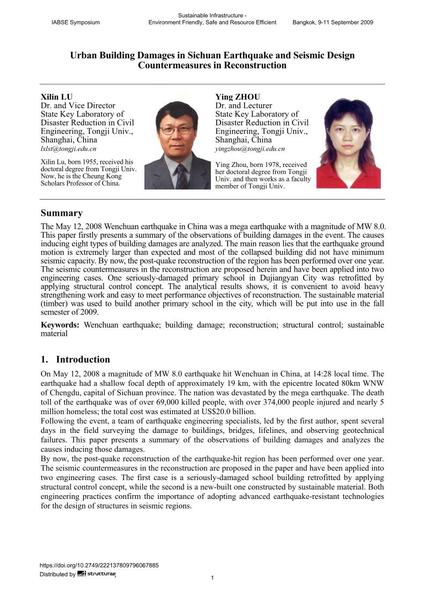Urban Building Damages in Sichuan Earthquake and Seismic Design Countermeasures in Reconstruction

|
|
|||||||||||
Bibliographic Details
| Author(s): |
Xilin Lu
Ying Zhou |
||||
|---|---|---|---|---|---|
| Medium: | conference paper | ||||
| Language(s): | English | ||||
| Conference: | IABSE Symposium: Sustainable Infrastructure - Environment Friendly, Safe and Resource Efficient, Bangkok, Thailand, 9-11 September 2009 | ||||
| Published in: | IABSE Symposium Bangkok 2009 | ||||
|
|||||
| Page(s): | 1-10 | ||||
| Total no. of pages: | 8 | ||||
| Year: | 2009 | ||||
| DOI: | 10.2749/222137809796067885 | ||||
| Abstract: |
The May 12, 2008 Wenchuan earthquake in China was a mega earthquake with a magnitude of MW 8.0. This paper firstly presents a summary of the observations of building damages in the event. The causes inducing eight types of building damages are analyzed. The main reason lies that the earthquake ground motion is extremely larger than expected and most of the collapsed building did not have minimum seismic capacity. By now, the post-quake reconstruction of the region has been performed over one year. The seismic countermeasures in the reconstruction are proposed herein and have been applied into two engineering cases. One seriously-damaged primary school in Dujiangyan City was retrofitted by applying structural control concept. The analytical results shows, it is convenient to avoid heavy strengthening work and easy to meet performance objectives of reconstruction. The sustainable material (timber) was used to build another primary school in the city, which will be put into use in the fall semester of 2009. |
||||
| Keywords: |
reconstruction building damage structural control Wenchuan earthquake sustainable material
|
||||
